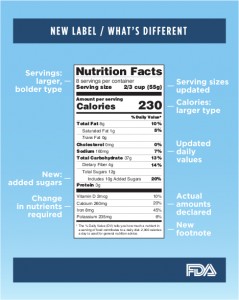New Food Labels Offer Sweet Strategy to Lose Weight
 Reading food labels to track calories and added sugars is an important strategy for anyone trying to lose weight.
Reading food labels to track calories and added sugars is an important strategy for anyone trying to lose weight.
And it may just get a little easier, thanks to the U.S. Food and Drug Administration. Officials at the agency recently unveiled how the labels on packaged foods are changing to make it easier for people to choose healthy foods and avoid overeating.
The new labels make it easier to figure out if something has any added sugars and how many calories are in a realistic portion size.
“For more than 20 years, Americans have relied on the Nutrition Facts label as a leading source of information regarding calories, fat and other nutrients to help them understand more about the foods they eat in a day,” said FDA Commissioner Robert Califf, M.D. “The updated label makes improvements to this valuable resource so consumers can make more informed food choices – one of the most important steps a person can take to reduce the risk of heart disease and obesity.”
Lose Weight by Reading Food Labels
Some say the changes are long overdue to help people lose weight. Too many children and adults in America are overweight. More than one-third of adults have obesity, putting them at risk for heart problems, stroke, type 2 diabetes and even certain cancers.
Making sense of food labels is something many people have to learn to do when they want to lose weight. Registered Dietitians help teach people how to use the labels to keep track of the calories, sodium, added sugars, carbohydrates and protein that they eat throughout the day.
One of the most noticeable changes to the Nutritional Facts label will be to what’s listed as a serving size. It’s being changed to depict the actual amount that a person eats or drinks. Although many sports drinks and sodas list two servings per bottle, one person often drinks the entire bottle.
Other changes include:
- Listing the grams and a percent daily value of “added sugars.” No more than 10 percent of a person’s total daily calories should come from added sugars, according to the FDA and the 2015-2020 Dietary Guidelines for Americans.
- “Dual column” labels to indicate both “per serving” and “per package” calorie and nutrition information for certain multi-serving food products that could be consumed in one or multiple sittings. With dual-column labels available, people will be able to easily understand how many calories and nutrients they are getting if they eat or drink the entire package or unit at one time.
- For packages that are between one and two servings, such as a 20-ounce soda, the calories and other nutrients will be required to be labeled as one serving.
- Updated daily values for nutrients like sodium, dietary fiber and vitamin D, will now be consistent with Institute of Medicine recommendations and the 2015-2020 Dietary Guidelines for Americans. Daily values are reference amounts of nutrients to consume or not to exceed and are used to calculate the %DV that manufacturers include on the label.
- Declaration of Vitamin D and potassium that will include the actual gram amount, in addition to the %DV. These are nutrients that some people are not getting enough of, which puts them at higher risk for chronic disease. The %DV for calcium and iron will continue to be required, along with the actual gram amount. Vitamins A and C will no longer be required because deficiencies of these vitamins are rare. However, these nutrients can be included on a voluntary basis.
- “Calories from Fat” will be removed because research shows the type of fat is more important than the amount. “Total Fat,” “Saturated Fat,” and “Trans Fat” will continue to be required.
Sources: FDA news release, Centers for Disease Control and Prevention
+ Do you need help changing your eating habits to improve your overall diet and to lose weight? Learn about the nutrition counseling program at Bon Secours In Motion. Our Registered Dietitians teach people how to make healthy food choices in their everyday diet to meet their nutritional and fitness needs.

